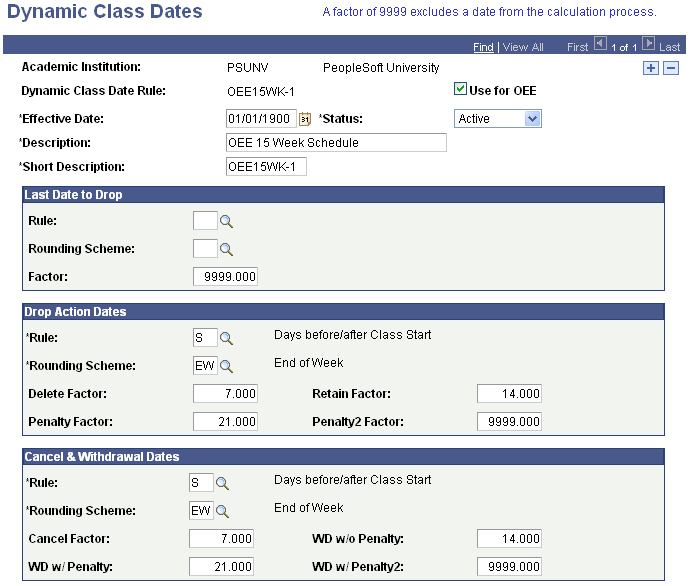Creating Dynamic Class Date Rules
To set up dynamic class date rules, use the Dynamic Class Dates component (DYN_CLASS_TBL).
This section discusses how to establish dynamic class date rules.
|
Page Name |
Definition Name |
Navigation |
Usage |
|---|---|---|---|
|
Dynamic Class Dates |
DYN_CLASS_DATA_TBL |
|
Establish dynamic class date rules and OEE dynamic date rules for an academic institution. Rules enable you to dynamically calculate cancel, withdrawal, and drop deadlines and other landmark dates. You then apply these rules to various parts of the academic structure so that you can calculate the landmark calendar dates for individual classes or student enrollments. |
Access the Dynamic Class Dates page ().
Image: Dynamic Class Dates page (1 of 2)
This example illustrates the fields and controls on the Dynamic Class Dates page (1 of 2). You can find definitions for the fields and controls later on this page.

Image: Dynamic Class Dates page (2 of 2)
This example illustrates the fields and controls on the Dynamic Class Dates page (2 of 2). You can find definitions for the fields and controls later on this page.

|
Field or Control |
Definition |
|---|---|
| Use for OEE (use for open entry/exit) |
Select to make this dynamic class date rule applicable only to OEE class sections. This option distinguishes the rule as an OEE dynamic date rule. Clear the check box to make the dynamic class date rule applicable only to regular dynamically dated class sections. Depending on your selection, the dates for which you must define rules, rounding schemes, and factors vary according to individual needs, as do the translate values for the Rule and Rounding Scheme fields. You must enter a value for this check box before defining rule schemes, rounding schemes, and factors. |
Last Date to Drop
In the Last Date to Drop group box, enter the rule scheme, rounding scheme, and factors that the Dynamic Dates process uses to calculate the last drop date for classes or OEE enrollments to which this rule applies.
Drop Action Dates
In the Drop Dates group box, enter the rule scheme, rounding scheme, and factors that the Dynamic Dates process uses to calculate the drop deadlines for classes or OEE enrollments to which this rule applies. The process assigns the reason code for the drop-and-retain-record deadline and the grade for the drop-with-penalty deadlines according to the student's primary academic program. Define reason codes and grades for drops by academic program on the Dynamic Date page of the Academic Program Table component.
Cancel & Withdrawal Dates
Enter the rule scheme, rounding scheme, and cancel factor that the Dynamic Class Dates process uses to calculate the cancel and withdrawal date deadlines for classes or OEE enrollments to which this rule applies. The process assigns the reason code for the cancellation, and the grade for the withdraw-with-penalty deadlines, according to the student's academic program. Define reason codes and grades for withdrawals by academic program on the Dynamic Dates page of the Academic Program Table component.
Lapse Start Date
Enter the rule scheme, rounding scheme, and factor that the Dynamic Class Dates process uses to calculate the lapse start date for classes or OEE enrollments to which this rule applies. The lapse start date is the first date on which a student's grade lapses. This date determines when the grade lapse rules go into effect for students.
Sixty Percent Point In Time
Enter the rule scheme, rounding scheme, and factor that the Dynamic Class Dates process uses to calculate the 60 percent point in time for classes or OEE enrollments to which this rule applies. The 60 percent point in time is the date that you consider the class or OEE enrollment to be 60 percent complete. The system uses this date when computing refunds. In the U.S., the majority of academic institutions stop issuing refunds at this point in time.
Census Date
Enter the rule scheme, rounding scheme, and factor that the Dynamic Class Dates process uses to calculate the census date for classes or OEE enrollments to which this rule applies. The census date is the official cutoff date for census statistics.
Fully Graded Date
Enter the rule scheme, rounding scheme, and factor that the Dynamic Class Dates process uses to calculate the date on which a student is considered to be fully graded for classes or OEE enrollments to which this rule applies. This field is optional. When you define transcript types, you can indicate on the Transcript Type – Basic Data page whether the transcript processes uses this date and displays grades for classes within the term.
Class End Date
Enter the rule scheme, rounding scheme, and factor that the Dynamic Class Dates process uses to calculate the end date of a class for OEE enrollments to which this rule applies. This field is unavailable for when you define OEE dynamic date rules.